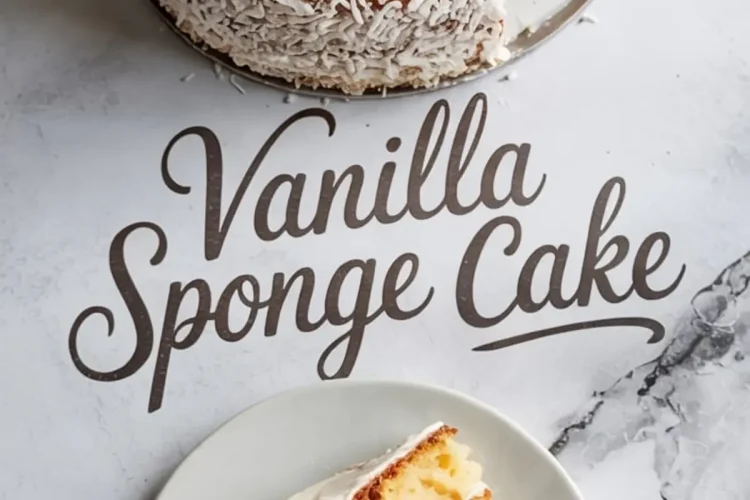If you’re searching for a moist vanilla sponge cake that holds its shape and still melts in the mouth, this recipe will give you the confidence you need.
You’ll learn how to make a soft, airy base that works for layer cakes, trifles, or a simple cream-covered treat. It’s the kind of easy sponge cake recipe you’ll keep coming back to, especially when you want a reliable structure without sacrificing tenderness.
This is the version I keep tucked into the front of my binder marked “Sponge Cake Recipe Best.” I’ve tested many, but this one checks every box. It’s simple, clean, and consistent. The ingredients are pantry staples, and the technique gives you just enough room to develop a rhythm without being difficult.
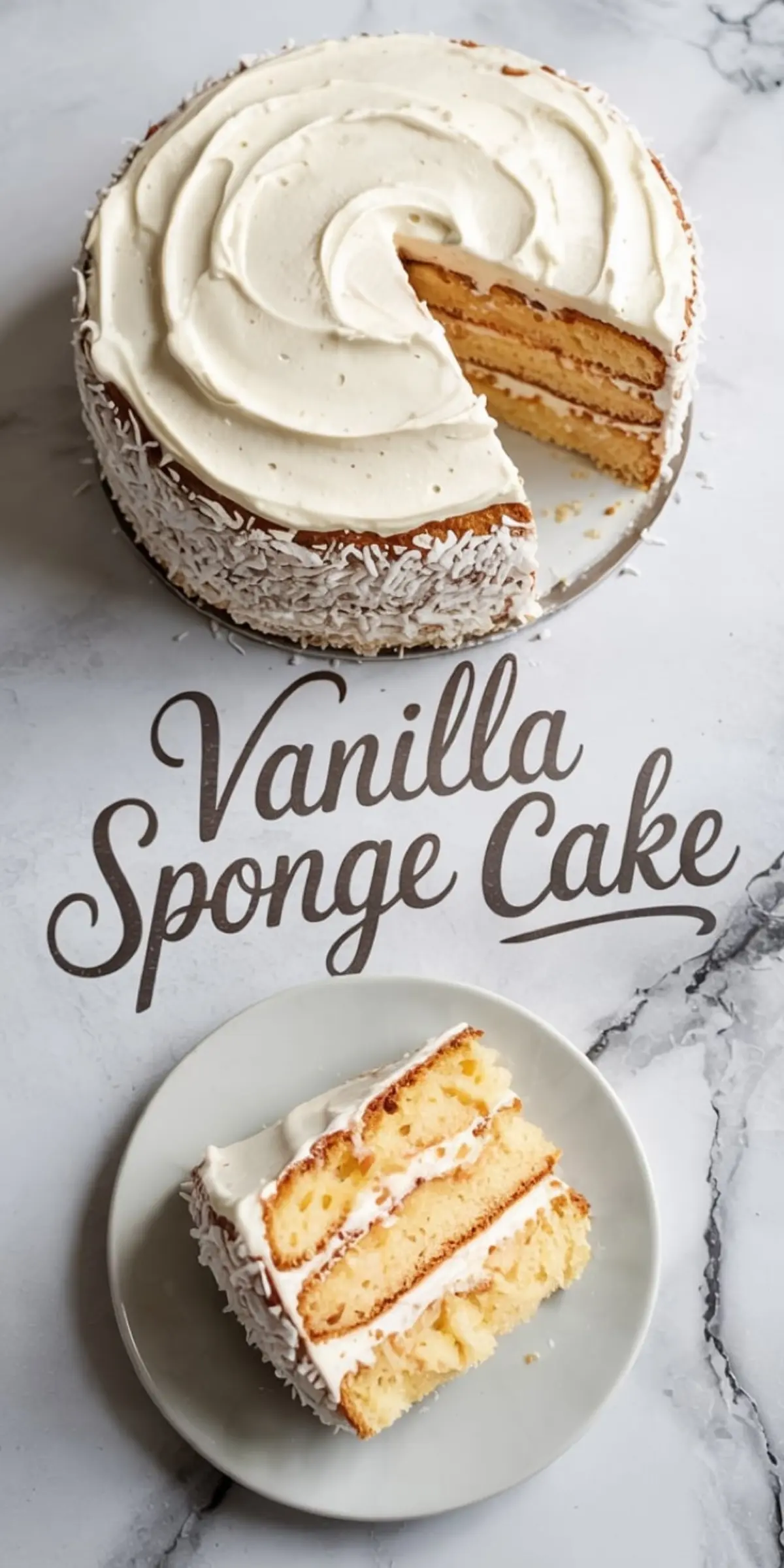
Why This Vanilla Sponge Cake Outperforms Basic Recipes
Most sponge cake recipes lean one of two ways. Either they stay too dense or they collapse trying to be too airy.
This one sits in the middle. The eggs give it lift without needing baking powder. The warm milk and melted butter bring moisture without flattening the crumb. The result is a golden, springy sponge that doesn’t dry out or deflate under cream.
You’ll find the process feels familiar if you’ve made any Simple Moist Vanilla Cake before. But the structure here comes from the eggs alone.
That means precision matters. Temperature. Timing. Gentle folding. I’ve written this recipe to guide you clearly through each step.
Ingredients with Purpose – Why Each One Matters
Start with six large eggs. They must be at room temperature. Cold eggs won’t aerate properly, and you’ll lose the lift that makes this cake so light.
Granulated sugar binds the air in the eggs, helping the batter triple in volume. It also gives the sponge its glossy surface and faint crisp edge.
Cake flour keeps the texture soft. I’ve tried using all-purpose flour in a pinch, but it adds weight. The difference is subtle but noticeable. For an easy sponge cake recipe that stays delicate, cake flour is your best bet.
Salt might seem small, but it sharpens the sweetness and rounds out the vanilla.
The warm milk and melted butter combination adds moisture and stability. If either one is too hot, it can deflate the batter. I usually mix them together first, let them sit a moment, then temper with a scoop of batter before folding back in.
And then comes the vanilla. Use a pure extract. The flavor comes through clean and soft. I’ve tried both extract and paste. For sponge cakes, extract keeps the crumb light in taste and color.
A Note on Whipped Vanilla Cream – Light and Reliable
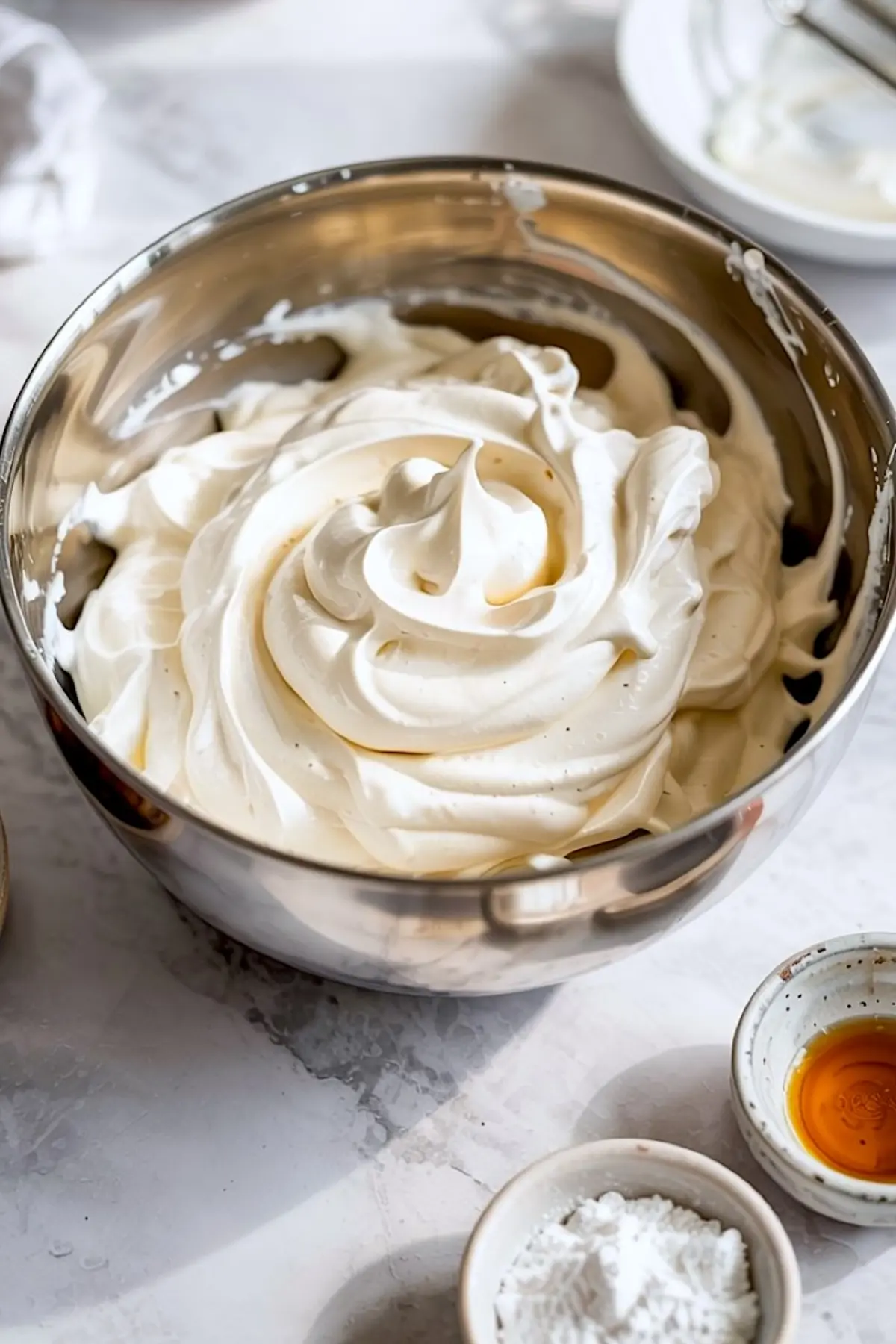
The whipped cream frosting here isn’t stiff or sugary. It’s meant to balance the sponge, not overpower it.
Use cold heavy whipping cream. If the bowl and beaters are cold too, the process becomes easier. Powdered sugar keeps the texture smooth and integrates quickly. I add the vanilla near the end, once soft peaks start forming.
Overwhipping ruins everything. Once the peaks hold but still look creamy not grainy you’re done.
You can use this cream on its own, or pipe it between layers. I’ve even used it on my Winter Vanilla Cake when I want something more subtle than buttercream.
Comparison: Cake Flour vs All-Purpose – Why the Flour Choice Matters
I’ve tested this cake with both. All-purpose flour works in a pinch, but the texture changes.
The crumb becomes tighter. The rise is slightly heavier. It’s still a sponge cake, but the mouthfeel leans more structured. Cake flour, on the other hand, gives that soft bite you expect from bakery-quality layers.
For celebrations or layered desserts, I always reach for cake flour. For a quick Sunday bake, all-purpose can pass. But for this recipe, use cake flour if it’s available. The result is a moist vanilla sponge cake with a much finer crumb.
How to Beat the Eggs to the Right Texture
Beating eggs and sugar for 8 to 10 minutes may sound excessive, but it’s essential.
The goal is triple volume. The mixture should look pale, thick, and fall in ribbons. If you stop too soon, the cake won’t rise. If you go too long, the texture becomes dry. I usually start checking at 8 minutes. The moment the batter folds back on itself and slowly disappears, it’s ready.
A small trick I’ve picked up—tilt the bowl gently. The mixture should stay put. That’s your sign.
Folding and Tempering – The Steps That Define This Cake
Flour needs to be sifted and added in three parts. No shortcuts here. Folding should be gentle, slow, and with intention.
Once the flour is in, the warm milk-butter-vanilla mixture gets folded next. But not all at once. Scoop out a bit of batter, stir it into the liquid mixture, then add it all back in. This prevents shocking the eggs and keeps the rise intact.
The batter should feel light, slightly warm, and glossy. Not runny, not dense.
Baking and Cooling – The Most Overlooked Step
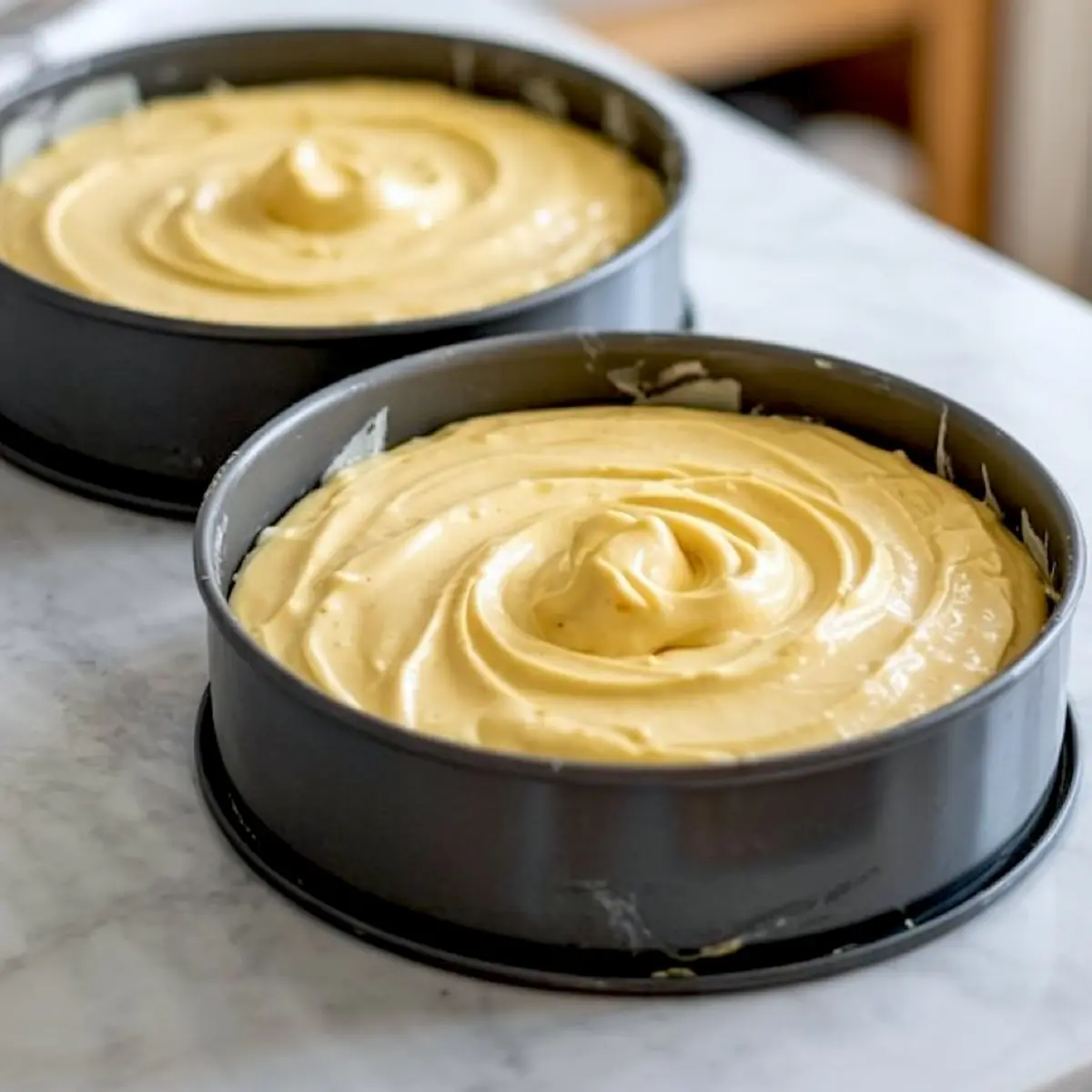
The pans should be lined only on the bottom. Do not grease the sides. This helps the batter cling and climb.
Bake at 340°F. No higher. A hot oven dries the sponge and browns it unevenly. The cakes should look golden, slightly domed, and spring back when gently pressed. Cool in the pan before removing.

I prefer assembling this cake the next day. Once the layers cool completely, I wrap them in plastic. Resting overnight improves the texture and makes slicing easier.
Serving, Garnish, and Storing Tips That Actually Matter
For garnish, shredded coconut or white chocolate curls are optional but helpful. They add visual contrast and give the sides a soft texture without extra sweetness.
This cake pairs well with fresh berries or fruit compote, especially when served plain. If you’re adding whipped cream between layers, frost just before serving.
Store leftovers in the fridge. The cream will firm up, but the sponge stays tender. Just let slices sit at room temperature for 15 minutes before serving again.
More Vanilla Cakes You’ll Want to Try Next
If you’re looking for something quicker, this Quick Vanilla Mug Cake delivers the same flavor with less time.
For holiday gatherings, this Winter Vanilla Cake offers a seasonal take with festive flavors.
Save This Vanilla Sponge Cake for Your Baking Board

This recipe belongs in your core collection. It’s consistent, balanced, and open to variation.
Pin it to your vanilla cakes board so it’s easy to find next time you need a birthday base, a brunch centerpiece, or something simple to show your skills.
If you try it, let me know in the comments. Did you use cream or layer it with fruit? I’d love to hear how it turned out for you.
Vanilla Sponge Cake Recipe
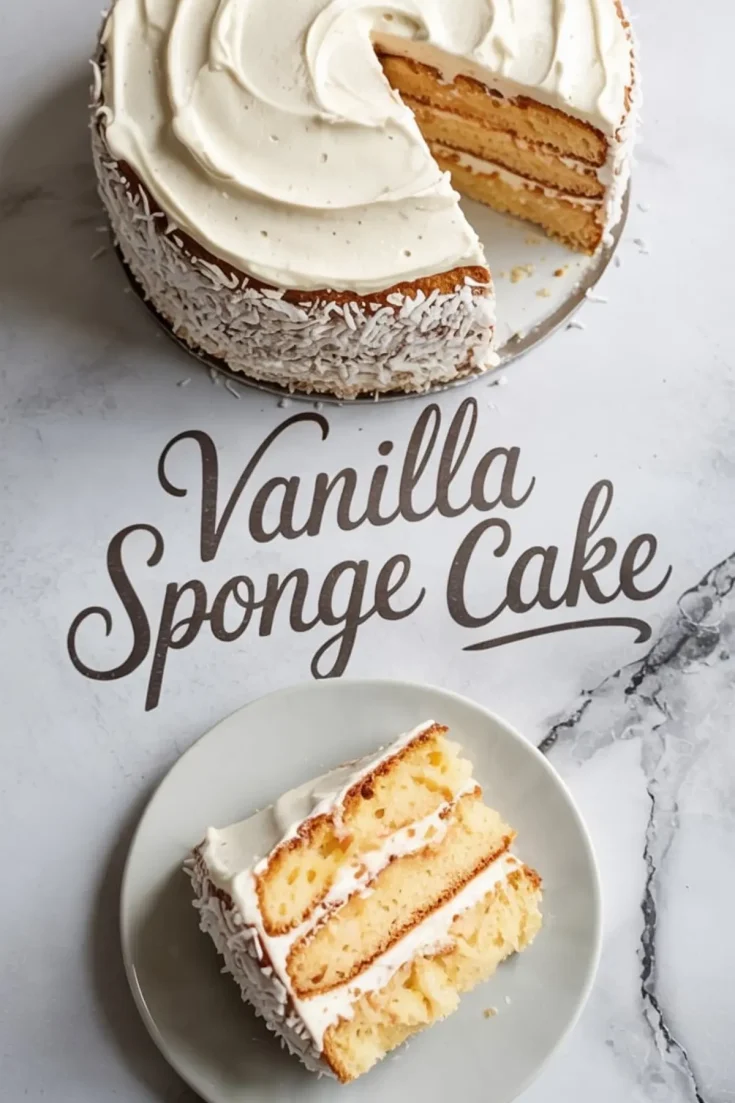
Vanilla sponge cake bakes up soft, airy, and golden with just the right balance of structure and lightness. I use this easy sponge cake recipe when I want something that holds its shape but still stays tender. It’s a moist vanilla sponge cake made with pantry staples—no fancy tools or ingredients. You can serve it plain, frost it, or layer it into a trifle. If you’re looking for a simple sponge cake that’s reliable, this one’s my go-to. I’ve tested a lot of sponge cake recipes, and this version is the one I keep in my binder under “sponge cake recipe best.” Add it to your list of cake basics or save it as your best vanilla sponge cake recipe for birthdays, brunches, or everyday baking.
Ingredients
- FOR THE SPONGE
- 6 large eggs, room temperature
- 1 cup (200g) granulated sugar
- 1 cup (120g) cake flour, sifted
- 1/4 cup (60ml) whole milk, warm
- 1/4 cup (60ml) unsalted butter, melted
- 1 ½ tsp pure vanilla extract
- 1/4 tsp salt
- FOR THE WHIPPED VANILLA CREAM FROSTING
- 2 cups (480ml) heavy whipping cream, cold
- 1/2 cup (60g) powdered sugar, sifted
- 1 tsp pure vanilla extract
- FOR THE GARNISH (OPTIONAL)
- Shredded coconut or white chocolate curls
Instructions
- PREPARE THE PANS: Preheat the oven to 340°F (170°C). Line the bottoms of two 8-inch round cake pans with parchment paper. Leave the sides ungreased to help the batter rise evenly.
- BEAT EGGS AND SUGAR: In a large bowl, beat the eggs and granulated sugar on high speed for 8 to 10 minutes until the mixture triples in volume, becomes pale, and falls in thick ribbons when lifted.
- FOLD IN DRY INGREDIENTS: Sift the cake flour and salt over the egg mixture in three additions. Gently fold with a spatula after each addition, mixing just until no flour streaks remain.
- INCORPORATE MILK MIXTURE: In a small bowl, combine the warm milk, melted butter, and vanilla extract. Stir a small scoop of the batter into the milk mixture to temper, then gently fold this back into the main batter until fully incorporated.
- BAKE THE SPONGE: Divide the batter evenly between the prepared pans. Bake for 22 to 25 minutes, or until the tops spring back when lightly pressed and a toothpick inserted in the center comes out clean. Cool completely in the pans on a wire rack.
- WHIP THE CREAM: In a chilled bowl, whip the cold heavy cream, powdered sugar, and vanilla extract on medium-high speed until soft peaks form. Be careful not to overwhip.
- ASSEMBLE THE CAKE: If needed, level the cooled sponge layers with a serrated knife. Place one layer on a serving plate, spread whipped cream on top, then add the second layer. Cover the top and sides with more whipped cream. Press shredded coconut or white chocolate curls onto the sides, if using.
Notes
Use room-temperature eggs to achieve maximum volume during beating.
Do not open the oven door while baking to avoid deflating the sponge.
The sponge can be made a day ahead and wrapped in plastic once cooled. Store at room temperature.
Frost just before serving for best texture.
Nutrition Information
Yield
12Serving Size
1Amount Per Serving Calories 232Total Fat 11gSaturated Fat 6gTrans Fat 0gUnsaturated Fat 4gCholesterol 116mgSodium 192mgCarbohydrates 26gFiber 1gSugar 15gProtein 6g

